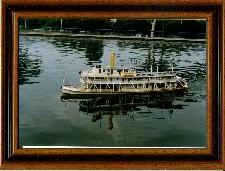
History:
The
Moyie of Vancouver was constructed in Toronto for service on the Stikine
lake. The stern wheeler was shipped in sections by railroad. When the gold
rush on the river deterred out, the boat was diverted to Nelson, where
she was assembled and launched in 1898. She inaugurated the Kootenay Landing-Nelson
Run which connected with the railroad from the east to the west. Her service
on the lake ended on the 27th April 1957.
She
was the last active stern wheeler in Canada. Today she is preserved in
the Kootenay Lake Historical Society at Kaslo, BC.
Two
sister ships were constructed for the same service. When the gold company
became bankrupt they were sold to The Amazon River Navigation, Manaus,
Brazil.
The
ships arrived in Brazil in sections as in Canada, and were used for rubber
and passenger transportation between Belem and Manaus.
As
the Amazon River is a very big river about 6 to 10 miles wide and more
than 3,000 miles long, this generates waves as high as 6 foot. The ships
were always in danger of sinking during tropical storms which is a very
usual scenario at the Amazon basin.
In
1913 they were dismantled in sections and transferred to Rio São
Francisco, Bahia.
A
brazilian company named San Francisco River Navigation (Companhia de Navegação
do São Francisco) renamed the boats with the names of “Benjamin
Guimarães” and “Delmiro Golveia” famous brazilians entrepreneurs.
The
Delmiro sunk in 1954 and the Benjamin Guimarães still exists as
a museum whose preservation quality adopted is unknown. Both boats were
the last active stern wheelers used in Brazil, the same history as in Canada.
The
model:
I ´ve been building
models since 1950, when I was twelve years old. My intention to build a
stern wheeler dates back to 1980, when I visited Disneyland, Los Angeles
CA. I sailed on the Mark Twain and I was astonished by the performance
of the boat
In
1985 I obtained the plans of construction, they were not good and rather
looked like a toy than a model. There was no engine design and the boat
was supposed to have an electric engine instead of a steam engine.
In
England a friend named Brian E. Hillsdon sent me the drawings of
the engines from “Marine Iron Works of Chicago, USA. I made my choice of
a single expansion, twin cylinder engine and constructed it.
The
boat s hull is made of fiberglass whit epoxy resin. The superstructure
is in wood, mainly Mahogany of high quality, and some parts as the connecting
rod (pitman) and engine holder of a typical hard Brazilian wood named
“Ypê” (this kind of wood sinks in water as the ebony does.)
The
duration of the work lasted four and half years from 1985 to 1989.
The
engine is made of brass and stainless steel, the boiler is made of copper
all silver soldered, and burns petroleum liquid gas, a mixture of propane
and butane.
The
engine is of 9/16” bore and 1 7/8” stroke, working pressure 30 PSI, it
has feed and oil pumps and an autonomy of approximately 2 hours without
refueling or watering.
The
colors are the same as the drawings illustrate, mainly white and the wheel
cover pale blue.
The
funnel is pale yellow turning to buff. The poles are black, the same color
as the sustaining ropes they hold. Since you cannot obtain the typical
sound with steam, the whistle is made of an old Lionel electric train and
turns with the battery of the radio control.
I
won several prizes in Brazil, and never took the boat overseas, due to
the size of the model.
The
original has 729 tons gross; 161 foot, length; 30 . ½ foot, breath
and the model is at a scale of 7/16” to 1 foot this means 5.1/2 ‘ length
and a weight of about 30 pounds.

For
further information, I can be contacted at: nautimodelismobr@yahoo.com.br